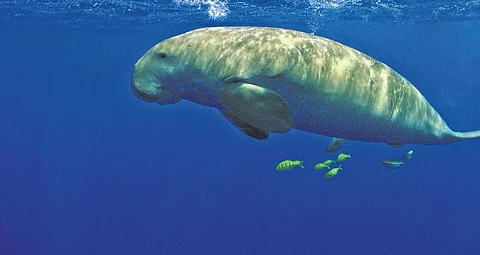

CHENNAI: In a first-of-its-kind initiative in the country, Tamil Nadu government on Wednesday issued a gazette notification stating 448.34 square kilometres (44,834 hectares) of coastal waters in Palk Bay from Adirampattinam village in Thanjavur to Ammapattinam in Pudukkottai as Dugong Conservation Reserve.
Additional Chief Secretary to Government in Environment, Climate Change and Forest Department, Supriya Sahu, told TNIE dugongs thrive primarily on seagrass beds, a major carbon sink of the oceans.
“Focussed conservation of dugongs will help protect and improve seagrass beds and sequestering more atmospheric carbon. Seagrass beds are also the breeding and feeding grounds for many commercially valuable fishes and marine fauna. Hence, thousands of fisher families directly get benefitted. The coastal communities along Palk Bay understand the need to conserve dugongs and they have been cooperating with the forest department in the conservation efforts,” Sahu said.
Chief Wildlife Warden, Srinivas Ramachandra Reddy, clarified traditional fishermen who depend on coastal waters for their livelihood will not be hampered with the declaration of conservation reserve. “We held extensive consultations and took fishermen communities into confidence. WII has already conducted baseline studies and more detailed research studies will be initiated roping-in other scientific institutions as well to assist our conservation efforts,” Reddy said.
Palk Bay is a shallow bay and the enclosed nature of the bay provides the ideal habitat for dugongs, dolphins, porpoises and turtles to frequent the region. The endangered dugongs live within 10-metre depth not far from the shore, usually in groups limited to 5 to 7 individuals among the seagrass beds. The official data show the coastal areas of Thanjavur and Pudukottai districts in Palk Bay is covered by around 12,250 hectares of seagrass beds, and protecting seagrass beds and dugongs in this area, will also help the breeding of commercially valuable finfish, crabs and shrimps.
Sahu said a few months ago a dugong calf that got entangled in fishing gear was successfully rescued and reunited with the mother by the artisanal fishermen in Palk Bay highlighting the involvement of fisherfolk in the species conservation.
Numbers speak
Total Perimeter of the Reserve
111.38 kilometres
Total Extent
448.34 Sq. kilometres
44,834.00 hectres